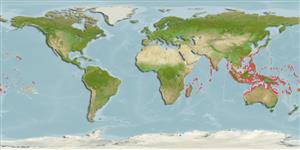>
Eupercaria/misc (Various families in series Eupercaria) >
Labridae (Wrasses) > Corinae
Etymology: Thalassoma: Greek, thalassa = the sea + Greek, soma = body; the colour of the sea (Ref. 45335).
Environment: milieu / climate zone / depth range / distribution range
Ecologia
marino associati a barriera corallina; non migratori; distribuzione batimetrica 0 - 15 m (Ref. 2334), usually 0 - 15 m (Ref. 27115). Tropical; 24°C - 28°C (Ref. 27115); 30°N - 32°S
Indo-Pacific: East Africa to the Line and Tuamoto islands, north to southern Japan, south to the Lord Howe and Austral islands.
Length at first maturity / Size / Peso / Age
Maturity: Lm 8.5 range ? - ? cm
Max length : 25.0 cm TL maschio/sesso non determinato; (Ref. 129178); common length : 15.0 cm TL maschio/sesso non determinato; (Ref. 6113)
Spine dorsali (totale): 8; Raggi dorsali molli (totale): 12-14; Spine anali 3; Raggi anali molli: 11. Color pattern remains similar with growth with terminal males becoming gaudier than primary males (Ref. 37816). Pale green with 6 dark bars, last two as saddles over the tail. Head with pink bands radiating from eye in large adults (Ref. 48636).
Occurs in shallow lagoon and seaward reefs, slopes and along drop-offs to moderate depths. Occurs in small, loose groups (Ref. 48636). Feeds on benthic and planktonic crustaceans, small fishes, and foraminiferans.
Life cycle and mating behavior
Maturità | Riproduzione | Deposizione | Uova | Fecundity | Larve
Oviparous, distinct pairing during breeding (Ref. 205).
Randall, J.E., G.R. Allen and R.C. Steene, 1990. Fishes of the Great Barrier Reef and Coral Sea. University of Hawaii Press, Honolulu, Hawaii. 506 p. (Ref. 2334)
IUCN Red List Status (Ref. 130435)
Threat to humans
Harmless
Human uses
Pesca: scarso interesse commerciale; Acquario: Commerciale
Informazioni ulteriori
BibliografiaAcquacolturaProfilo di acquacolturaVarietàGeneticaElectrophoresesEreditarietàMalattieElaborazioneNutrientsMass conversion
Strumenti
Special reports
Download XML
Fonti Internet
Estimates based on models
Preferred temperature (Ref.
123201): 24.8 - 29.3, mean 28.4 °C (based on 2928 cells).
Phylogenetic diversity index (Ref.
82804): PD
50 = 0.5000 [Uniqueness, from 0.5 = low to 2.0 = high].
Bayesian length-weight: a=0.00955 (0.00610 - 0.01496), b=3.05 (2.92 - 3.18), in cm total length, based on LWR estimates for this species & Genus-body shape (Ref.
93245).
Trophic level (Ref.
69278): 3.5 ±0.37 se; based on food items.
Generation time: 1.1 ( na - na) years. Estimated as median ln(3)/K based on 1
growth studies.
Resilienza (Ref.
120179): Alto, tempo minimo di raddoppiamento della popolazione meno di 15 mesi (K=1).
Fishing Vulnerability (Ref.
59153): Low vulnerability (16 of 100).
Nutrients (Ref.
124155): Calcium = 95 [56, 166] mg/100g; Iron = 0.852 [0.482, 1.541] mg/100g; Protein = 18.7 [15.9, 20.9] %; Omega3 = 0.143 [0.090, 0.227] g/100g; Selenium = 26.4 [15.6, 48.5] μg/100g; VitaminA = 81.9 [26.2, 301.9] μg/100g; Zinc = 1.66 [1.13, 2.60] mg/100g (wet weight);
